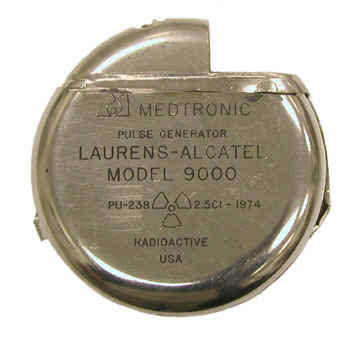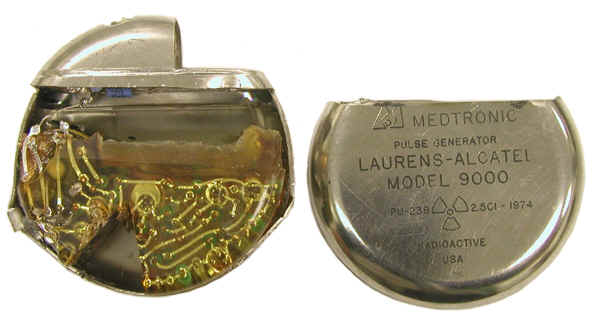Plutonium Powered Pacemaker (1974)

Pacemakers are used to stimulate a regular heartbeat when the body's natural electrical pacing system is irregular or not transmitting properly.
Over the years, various power sources have been used for pacemakers, including thermoelectric batteries containing 2 to 4 curies of plutonium-238 (88 year half-life). As the term "thermoelectric" implies, the heat from the decaying plutonium is used to generate the electricity that stimulates the heart. At present (2003), there are between 50 and 100 people in the U.S. who have nuclear powered pacemakers. When one of these individuals dies, the pacemaker is supposed to be removed and shipped to Los Alamos where the plutonium will be recovered.
The pacemaker shown in these photos, produced by Medtronic, has had its plutonium removed.

As can be seen in the above photo, the unit's electronics are embedded in epoxy. The hard titanium case is designed to withstand any credible event including gunshots and cremation.
Dose rates at the surface of the pacemaker are approximately 5 to 15 mrem per hour from the emitted gamma rays and neutrons. The whole-body exposure is estimated to be approximately 0.1 rem per year to the patient and approximately 7.5 mrem per year to the patient's spouse.
Three U.S. companies manufactured these devices: the Cordis Corporation, Medtronic Inc. and Coratomic Inc.
Size: ca. 2.75" in diameter.
Donated by the Los Alamos National Laboratory Source Recovery Program.
References
- National Council on Radiation Protection and Measurements. NCRP Report No. 95. Radiation Exposure of the US Population from Consumer Products and Miscellaneous Sources. 1987.
- William Kolb and Paul Frame. Living With Radiation: the First Hundred Years. Third Ed. Syntec Inc. 2002.
